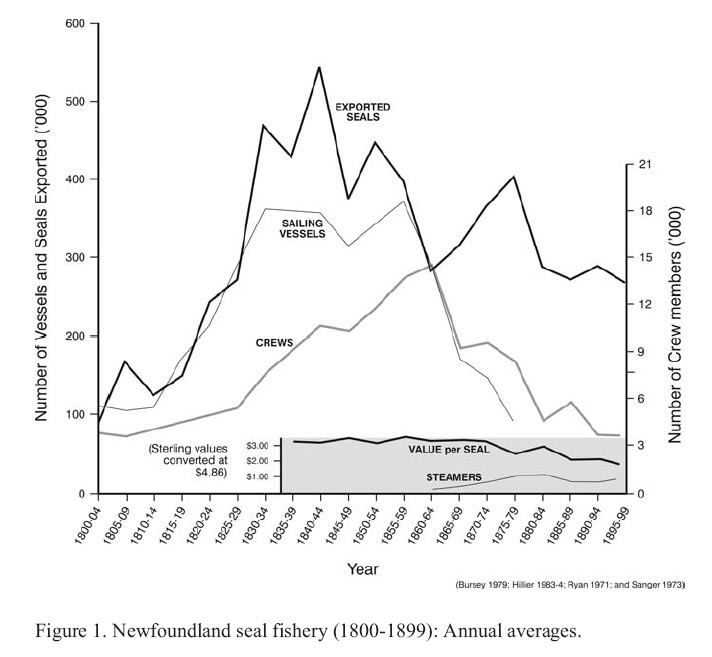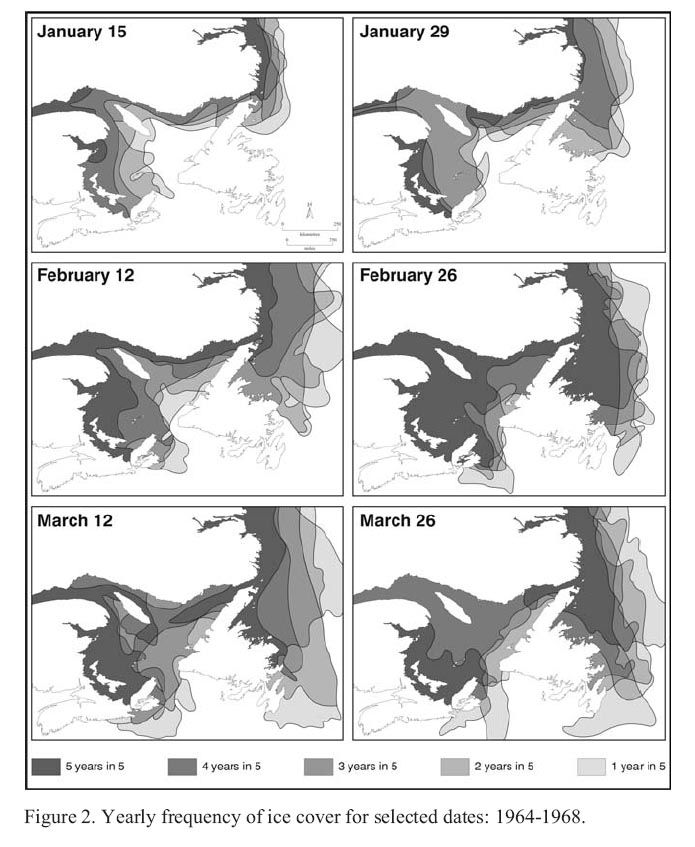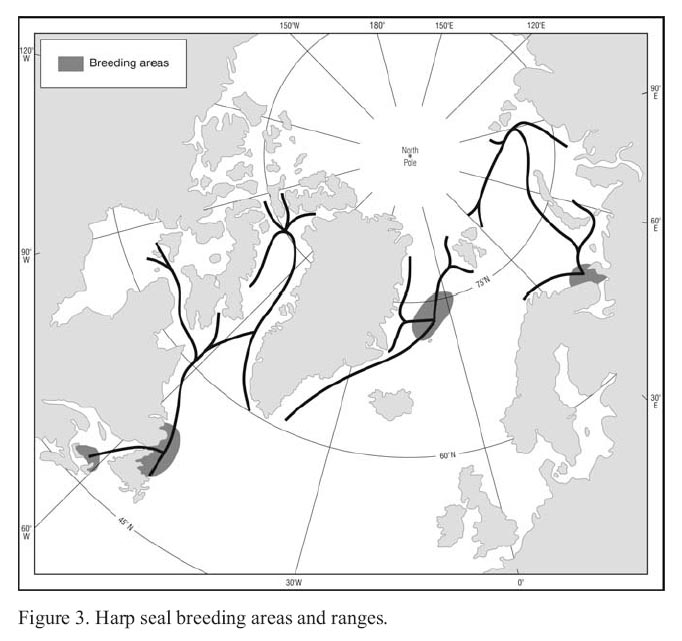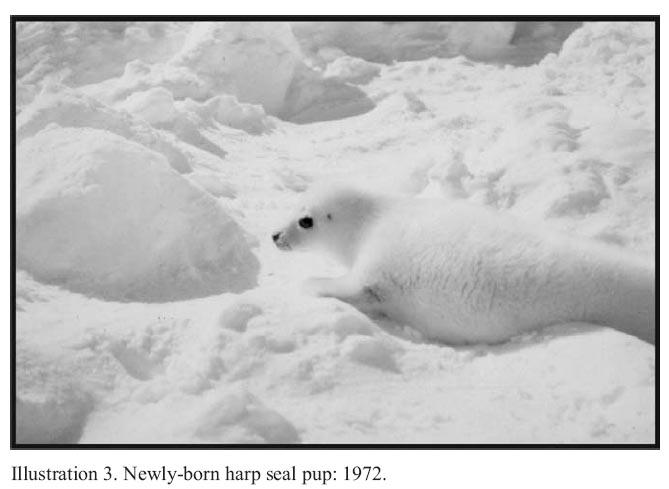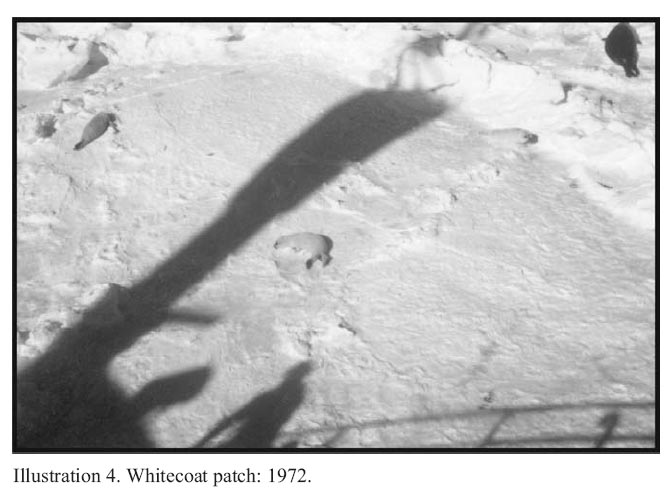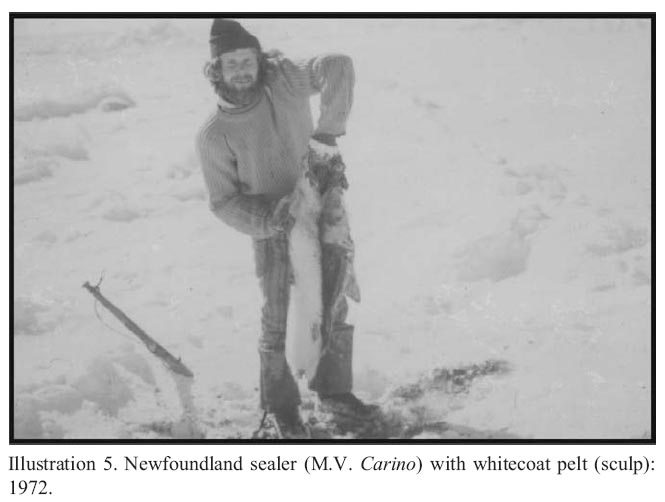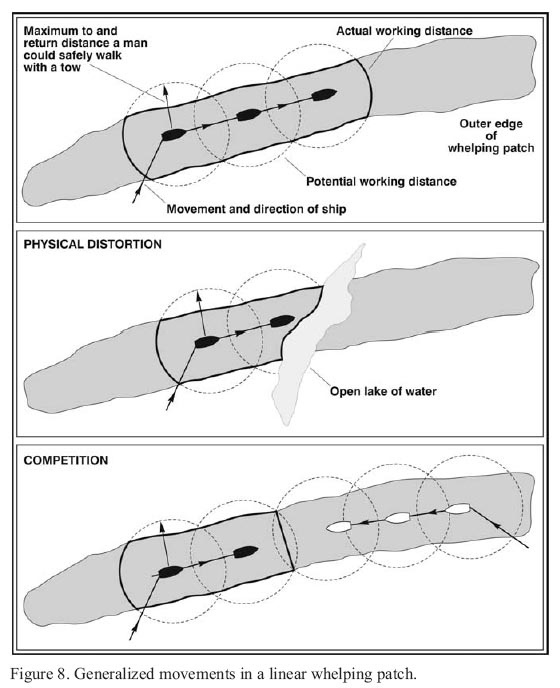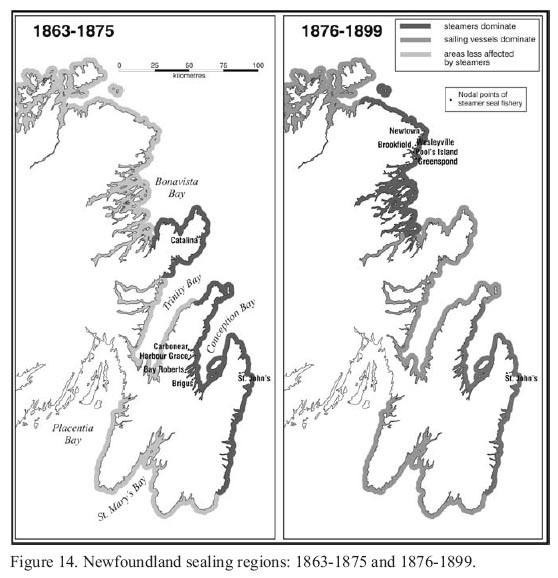Articles
Sail versus Steam:
Post 1863 Technological and Spatial Adaptation in the Newfoundland Seal Fishery
Chelsey W. SangerMemorial University of Newfoundland
csanger@mun.ca
INTRODUCTION
1 THE INTRODUCTION OF SCREW-STEAMERS in 1863 profoundly changed the Newfoundland seal fishery (Figure 1). Offshore sealing has essentially two components — the search, or "hunt," for the resource, followed by the actual harvesting. This paper examines the impact steamers had on both, and thus the industry as a whole. To understand better the new strategies that emerged after the adoption of steam powered vessels, it is useful to examine the history of the trade, income sharing, and fundamental characteristics that remained relatively unaltered through the transformation from sail to steam.
Figure 1. Newfoundland seal fishery (1800-1899): Annual averages.INDUSTRIAL HISTORY
2 To capture harp seals from shore, the early inhabitants of northeastern Newfoundland and southern Labrador developed two techniques — the use of nets and traps (Head 1971; Sanger 1977; Sanger 1998a). Towards the end of the eighteenth century, merchants and investors in St. John’s and the larger Conception Bay communities fitted out sailing vessels for offshore sealing (Wilson 1866, 287. Ryan 1994a provides the best overview of the trade. See, also, Bonnycastle 1842; Busch 1985; Candow 1989; England 1969; Greene 1933; Kean 1935; Ryan 1994b; Ryan 2007; Sanger 1973; and Sanger 1998b). The first were fishing schooners designed primarily for use in the newly established Labrador floater cod fishery (Black 1960; Butt 1998; Cuff 1991; Ryan 1971; and Ryan 1986). This dichotomy — sealing vessels for two months of the year and otherwise employed for ten — is illustrated by the fact that of 50 ships which cleared for the ice from Harbour Grace in 1867, 36 also participated in the Labrador fishery at the end of the sealing voyage (Ryan 1971, 52). The success of these two complementary activities was rapid. The number of skins exported, for example, increased from less than 5,000 in 1793, to 81,000 in 1805, 281,000 in 1819, and 687,000, the highest number ever reported, in 1831. By the early 1850s, however, the sailing vessel endeavour had reached its peak due to over-exploitation (Figure 1).
3 St John’s-based merchants hoped that steamers, with more reliable propulsion, greater size, extra strength, larger crews, and steam-powered deck equipment would reinvigorate the industry. The vessels immediately demonstrated a superior ability to contend with the challenges and dangers posed by southward flowing pack ice that for three to four weeks each spring became the breeding ground for migrating harp seals, the principal target of the industry (Figures 2 and 3; Illustrations 1, 2, 3, and 4).1 Unable to compete, schooners quickly gave way to screw-steamers. Although faster and more reliable access to the resource and enhanced harvesting capabilities brought a brief resurgence, continued over-exploitation and ineffective legislation soon caused the industry to decline at an even faster pace than had occurred prior to 1863.
Figure 2. Yearly frequency of ice cover for selected dates: 1964-1968.Figure 3. Harp seal breeding areas and ranges.INCOME SHARING
4 Proceeds during the sailing vessel period were divided among sealers, masters, and owners according to pre-arranged agreements. Merchants/owners supplied "all the boats, sealing gear, powder, shot and provisions, in consideration of which they are entitled to one half the seals, old and young" (Carroll 1873, 9). The captain, if an owner, received "four pence to six pence for each seal the vessel brings in, or one shilling to one shilling and three pence per cwt. [112 lbs.] according to the agreement that may be made between them previous to the commencement of the voyage" (LeMarchant 1848, 148). Normally, the remainder was shared equally among all members of the crew. Ordinary sealers were usually paid in both kind and cash. In 1828, for example, Philip Gosse recorded that "each man was allowed to take up goods on credit of the voyage, to a certain amount, perhaps one-third, or even one-half, of his probable earnings" (Gosse 1890, 48).
5 Sealers on ships that had poor voyages, consequently, were left in debt to the merchants as they signed notes for the goods, or "crops," they received in advance. Additionally, since demand invariably exceeded supply, applicants were often required to pay "a sum varying from ten shillings to thirty-five shillings for being allowed to proceed in the vessel, which is called Berth Money, each man has to find a gun, or pay the hire of one and also has to find twenty-five sticks of firewood for fuel while on the voyage" (LeMarchant 1848, 148).
6 In 1806, at the beginning of the offshore fishery, sealers could expect to earn "from £25 for their few weeks’ work" (Head 1971, 337). By 1819, however, Anspach noted that the expected earnings could range from only "nine to twelve pounds sterling per man" (Anspach 1819, 423). As newer and bigger vessels, each carrying larger crews, were introduced, the costs and risks of failure in the face of a rapidly declining resource, grew correspondingly greater. In the absence of substantial increases in the price of seal products, profits and wages continued to decrease throughout the middle decades of the nineteenth century (Sanger 1973, 186).2
7 Steamers, on the other hand, were more expensive to purchase, fit out, and operate. Sealing companies, therefore, increased their share of the pelts from one-third to one-half. For the most part, however, sealers no longer had to pay berth money, though cropping continued to be fairly common.3
8 As long as crew sizes and the number of steamers remained relatively small, there was an immediate increase in wages. In 1865, for example, the 120 sealers in the Wolf individually earned $92.00, while in 1868 the 128 crewmen sailing in the Lion made $120.00 each. By the late 1880s, however, average earnings had declined to approximately $30.00 (for full details, see Sanger 1973, 183-98). Although certain vessels, as during the sailing period, were known to be "good iceboats" and many captains had earned the reputation of being successful "Jowlers," the individual sealer’s chance of making a paying voyage could vary widely from year to year. The seal fishery, consequently, continued to be in fact and perception a lottery. The amount sealers could earn, then, increased dramatically following the introduction of steamers. This trend, however, was brief and within less than half a century wages and profits were again in a state of decline similar to that which had been evident towards the end of the sailing vessel era.
Illustration 1. M.V. Carino in pack ice off northern Newfoundland: 1972.
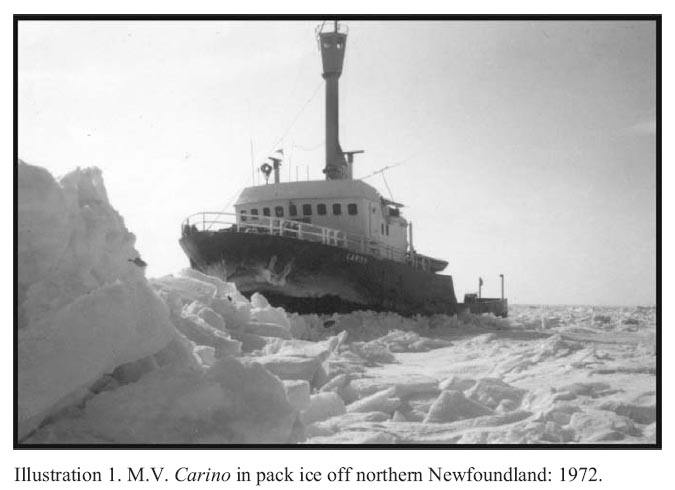
Display large image of Illustration 1
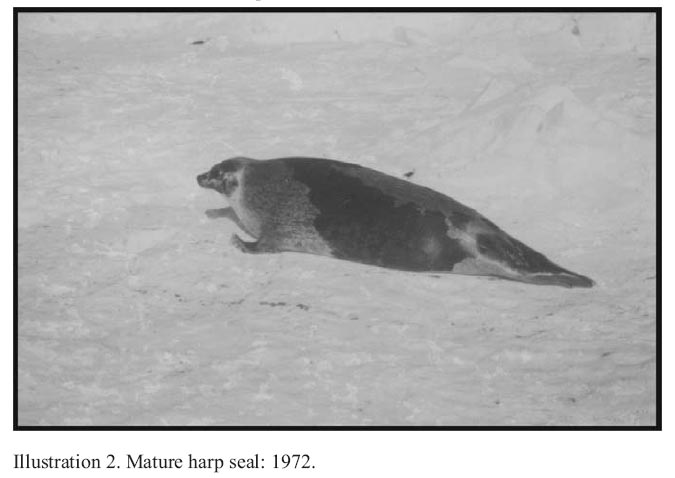
Display large image of Illustration 2
FUNDAMENTAL CHARACTERISTICS
Personnel Organization
9 After leaving port, the first task during the sailing vessel era was the division of a ship’s company into three watches. Except in cases where all hands were needed to work the ship, they rotated, with "master-watches" acting as mates when on duty. While even the largest sailing ship seldom carried more than 50 sealers, steamer crews often exceeded 300 men. They therefore had at least four watches rather than three, with each larger than the entire crew of a sailing vessel (Vey 1971, personal communication). In 1840, for example, the brigantine Topaz carried 36 sealers divided into three 12 man watches (Jukes 1842, 259). Even after legislation restricted crew size towards the end of the nineteenth century, up to 270 men could still be hired (for full details on the evolution of sealing legislation, see Ryan 1994a).
10 Individual watches were fairly homogeneous in terms of kinship and community ties during the sailing vessel era, as the entire crew would have been generally well known to master-watches. On steamers, however, the practice, of necessity, was more arbitrary, with men normally chosen in rotation from the ship’s list. Although sealers were provided with an opportunity to "change over," they had to have "the master-watch’s permission. Sometimes he’d oblige, sometimes not" (Kean 1971, personal communication). Each watch, in turn, was subdivided into smaller units under quarter-masters, or "deck-routers," while sealers were hired as gunmen, gunmen without guns, and "batsmen," the largest and least skilled category (Maxwell 1874, 265).
Killing and Harvesting: Equipment and Techniques
11 Initially sealers used boat hooks or gaffs, which also functioned as aids and safety devices when working on loose and fragmented ice, to club the whitecoat pups, crushing the skull. Though less often, they also sometimes employed simple homecarved wooden clubs, or bats (Archibald 1852, 4). This practice continued until 1967 when the Canadian government, in response to pressure from groups such as the International Fund for Animal Welfare, prohibited the use of the gaff. Only whitecoats could be killed by a blow to the head, beaters and mature harps normally fled into the water at the approach of a sealer and thus had to be shot with "sealing guns," a less-efficient practice.4
12 An experienced sealer, using what is effectively a butchering or carving knife, could remove a pelt, or "sculp" — the fat, hide, and fore flippers as one assembly — from the carcass in less than a minute (Sanger 1972, personal observation; Illustration 5). Besides the stone and steel needed to keep knife edges sharp, sealers also carried ropes for collecting and dragging pelts. Depending on weight and distance, an average tow consisted of three or four sculps (Perry 1971, personal communication; and Sanger 1972, personal observation). Although increased maneuverability offered by the steamers reduced this component of a sealer’s on-ice workload significantly, towing remained an integral part of the industry (Illustration 6).
Illustration 5. Newfoundland sealer (M.V. Carino) with whitecoat pelt (sculp): 1972.ACCESS TO THE WHELPING PATCH
Sailing Vessels
13 Despite the fact that there was a long-lived prejudice against employing vessels over 60 tons, as they were considered too big and too heavy to prosecute the fishery successfully, in an attempt to gain an advantage over their competitors more enterprising owners began to build and fit out larger sailing vessels during the early part of the nineteenth century (LeMarchant 1848, 147). It soon became clear that they performed better in ice (Chafe 1924, 22). By 1857, just six years prior to the introduction of the first steamer, several sailing vessels exceeded 200 tons burden (Hatton and Harvey 1883, 248).
14 While larger ships could carry more sealers, an advantage in the harvesting of the resource, the major reason owners invested the additional capital was the larger vessels’ ability to gain more reliable access to the whelping patch before the whitecoats had matured into beaters. According to Levi Chafe, a long-time compiler of statistics about the industry, the first improvement was higher masts to catch the wind in ice. To gain the full benefits of every breeze, no matter how light and temporary, vessels were fitted out for sealing with square top-sails. Smaller two-masters had extra rigging attached to the foremast and were called "Beaver Hat Men," while the bigger ships, with top-sails on each of their two or three masts, were known as "Jack Ass Brigs" (Chafe 1924, 17).
Illustration 6. Towing pelts — 1972 and c. late nineteenth century.
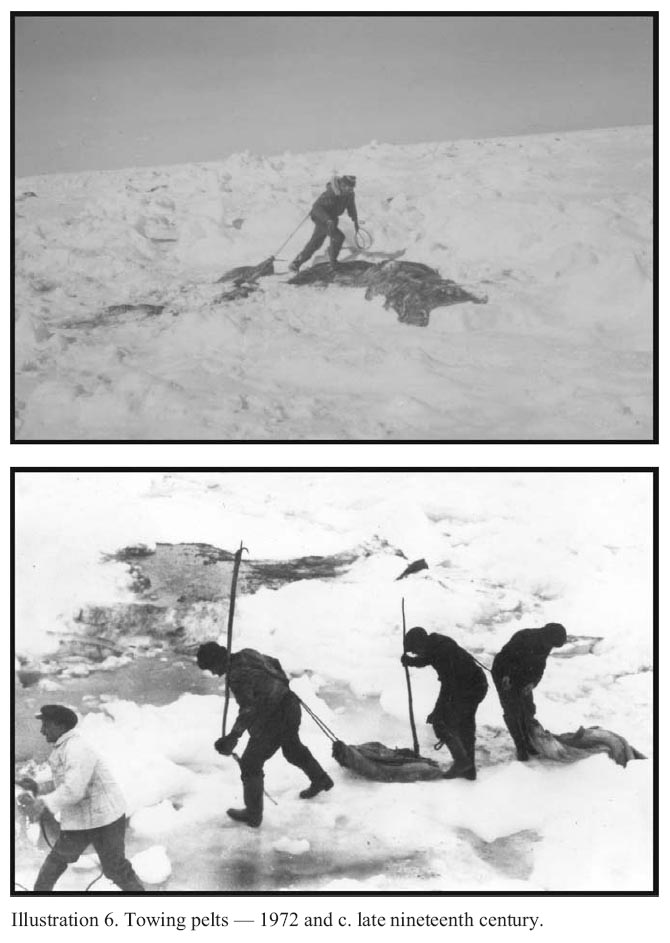
Display large image of Illustration 6
15 Because sailing vessels were designed primarily for fishing, their hulls had to be modified each spring. Bows, for example, were covered with hardwood sheeting, ideally greenheart (British Guiana timber), but more frequently, especially in the beginning, sealers used local hardwoods such as birch. In most instances, reinforcements above and below the water line were added to at least three-quarters of the ship’s length. The bows were further strengthened with iron plates. Additionally, false beams were laid out at approximately eight-foot intervals to help offset crippling lateral pressure compressing ice could bring to bear.
16 Holds were also modified. Heat generated by pelts stowed below and natural decay, when combined with the ship’s motion, could cause cargos to shift, placing vessels at risk, especially in rough seas. Such was the case in 1840 when the 130-ton schooner Topaz sank because the captain failed to take proper precautions (Jukes 1842, 279). It became standard practice, therefore, to subdivide the hold into "pounds" — smaller compartments — which restricted movement and ensured, through an elaborate loading procedure, that the centre of gravity would remain relatively stationary.5 Throughout the first half of the nineteenth century, then, the seasonal fitting out of sailing vessels for the seal fishery and the subsequent removal of these devices prior to the beginning of the Labrador cod fishery contributed significantly to the economies of St. John’s and many of the east coast communities stretching as far north as Notre Dame Bay (Figure 4).
Figure 4. Location map.
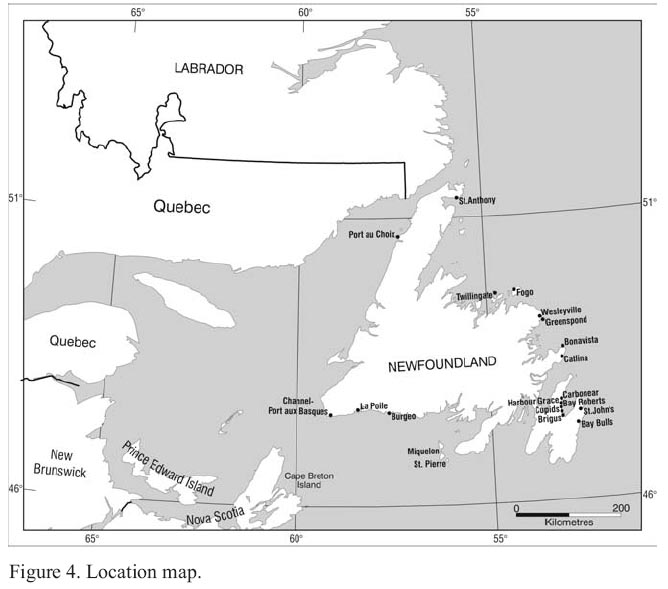
Display large image of Figure 4
17 Men hired during the sailing vessel period were both sailors and sealers, the former role being all important as they competed to be first in the whelping patch. To intercept successfully harp pups being carried southward on the ice floes, masters were usually forced to enter the pack soon after clearing port (Figure 2).6 Progress northward depended to a large degree on ice (quantity and composition), wind (direction, strength, and duration), temperatures, and currents.7 Facing difficult and often dangerous conditions, captains, as one participant explained in 1842, "accordingly crowded all sail, and cracked on with a fresh breeze, urging way now through slowly yielding pans, now sailing gallantly through an open lake of water, and then crashing into a great sheet of ice, splitting it with a mighty fissure, but brought up ourselves all standing and top-gallants set" (Jukes 1842, 264).
18 Newly formed ice offered relatively little resistance thus permitting the use of "rams" (Figure 5) — two poles approximately ten inches in the butt and six inches at the other end connected to the bow and joined together beneath the bowsprit (Greenham 1971, personal communication). The whole apparatus could be raised or lowered by means of a spring tackle (Peddel 1908, 6). Sealers, using the rams for support, would "jump and dance on the ice and breaking it with their weight, shoving it below the vessel, and dragging her on over it with all their force" (Jukes 1842, 262).
Figure 5. Sailing vessel equipped with rams.

Display large image of Figure 5
19 If the ice was loose and fragmented, "pokers" and boat gaffs helped clear a path. As vessels penetrated further into the pack, navigation normally became more difficult. Crew members used axes, ice-saws, and chisels to cut channels and all hands helped to tow and winch the ship forward.8 Under extreme pressure, sticks were lowered to act as fenders (Bonnycastle 1842, 143) and berths, or "beds," were often cut into larger pans in an attempt to provide safe refuge (Figure 6).
Figure 6. Schematic sketch of a ship’s bed.

Display large image of Figure 6
20 Progress through the ice pack depended largely upon a master’s knowledge and experience. The ability to be among the first to reach the resource, however, was also governed to a large extent by the efforts of the crew, who were motivated by personal pride, reputation, and the promise of greater financial reward. As one observer explained, the most successful captains had "the best men, and the hardest-working, showing the sterns of their vessels to the others, who were thus forced to give them best" (Greene 1933, 16). Interestingly enough, masters and crews were often reluctant to take advantage of a competitor’s hard won gains as "it was beneath their pride to steer in another man’s channel, and when it came to ice saws and rams, it was the hardest worker who won the day" (Chafe 1924, 16). By the late 1850s, a rapidly expanding fleet of increasingly larger sailing vessels crewed by more knowledgeable and experienced captains and men caused the size of the harp seal stock to decline dramatically. Before a sustainable participation level could be re-established, however, steamers were introduced in 1863.
STEAMERS
21 The appearance of two Scottish steam-powered whalers on the Newfoundland sealing grounds in 1862 acted as the catalyst.9 Two local companies, recognizing the superiority of the new technology, purchased ice-strengthened, screw-steamers in time for the following season. Walter Grieve and Company bought the Wolf, built by Alexander Stephen and Sons, Dundee, and Baine, Johnston, and Company obtained the Bloodhound from Greenock owners (Dundee Courier, 23 January 1863; and The Newfoundland Express, 28 February 1863). By 1867 there were eight steamers crewed by 128 sealers on average, compared to the 40-50 men carried on the very largest sailing ships. Within four years, ten per cent of all sealers were employed on steamers (Andrews and Parker 1971, 9) and by 1883 the number of sealing schooners clearing from St. John’s had declined from approximately 100 prior to 1863 to "some half-dozen" (Hatton and Harvey 1883, 251). Twelve years later a knowledgeable commentator noted that "the sealing vessels have now nearly all been superseded by steamers, from 300 to 600 tons, carrying from 150 to 280 men each" (Tocque 1895, 192). Altogether, 58 wooden steamers participated in the Newfoundland seal fishery between 1863 and 1906 when steel vessels first appeared.
22 Since the technical knowledge, expertise, and facilities required to build steamers was not available in Newfoundland, their introduction had an immediate and negative effect on the local shipbuilding industry. Within the seal fishery, itself, individual crew sizes quadrupled. The total numbers of ships, owners, masters, and sealers, however, once again dropped dramatically (Figure 1).
23 All of these changes were brought about primarily by the steamers’ enhanced ice navigation ability, the principal characteristic differentiating them from their sail-powered competitors.10 As masters and crews gained experience in their use, initial catches improved significantly. In 1866, for example, the Bloodhound was the first to return with 10,000 pelts and just two years later three steamers exceeded that number (Chafe 1924, 48).
24 While sailing vessel owners were annually responsible for expensive fitting out and decommissioning costs associated with having to adapt fishing schooners for the seal hunt each spring, steamers were built specifically for sealing and whaling in ice infested waters (Sanger 1980; Sanger 1988). In 1874, for example, Lieutenant William Maxwell, a Royal Navy navigation officer, participated in the Newfoundland seal fishery as an observer on board the Bear. His report to the Hydrographer of the Admiralty included a detailed description of the unique characteristics that made steamers particularly suited for ice navigation (Maxwell 1874, 264-7; see also, Greene 1933; Grenfell 1897; McGrath 1903; Nansen 1925; Pearce 1917; Tait 1939; and Willey 1907). The Bear, 463 tons, was built at Dundee, Scotland, by A. Stephens and Company. Heavy oak timbers were used in her construction and the entire hull was encased with an ice-sheathing of three-inch, greenheart planking. The bow was further protected by iron plating. The rudder and propeller were, of course, also strengthened and protected.
25 Additionally, steamers, with their greater speed, required stronger reinforcements forward. While modifications to the bows of sailing vessels were temporary, the pounding which steamers took meant that their "fortifications" were permanent. Stems were also sharper with gentler pitches that helped propel them upwards and forward onto the ice, thus breaking the floes with their weight. Without these attributes a ship was not considered a good ice-boat. As Fridtjof Nansen complained of the Magdalena, "her bow was not well shaped for going through the ice; it was too vertical, so that she could not run up on to the floes, while it strained the ship too much when she charged them" (Nansen 1925, 143).
26 The full potential of the steamers was not immediately realized. While this initially was due primarily to a relative lack of power, it can also be attributed to the inexperience of the captains and men who had learned their trades on sailing vessels. They soon recognized the limitations and strengths of the new technology, however, and were quick to adapt proven ice navigation techniques and strategies. Aubyn Pearce, for example, a sealer on the steamer, Osprey, recorded in his diary on Sunday, 17 March 1867, that they had "about sixty men ahead with a rope and twenty on the shears, with them and full steam we have loosened her" (Pearce 1917, 18). Shears were similar to the rams which had been used by schooner crews, being simply two spars which were "crossed and lashed at one end and suspended from the bows with heavy chains that cross from the bowsprit-cap and one of the other ends on each side from the cat-head. They were intended for men to jump on from the ice when coming on board, or as a temporary resting-place when breaking the ice from the bows or guiding the vessel, and for these purposes man-ropes are slung and a ladder led from the bulwarks to them and the ice" (Maxwell 1874, 265).
27 The relatively small number of sealers carried by a sailing vessel also meant that in most instances only one task could be performed at a time. Steamer crews, on the other hand, sometimes exceeded 300.11 Consequently, separate groups could be deployed simultaneously cutting, sawing, using pokers and gaffs, and towing. Additionally, steamer captains introduced entirely new techniques designed to take advantage of the larger number of men they commanded. When attempting to breach particularly difficult stretches of ice, for instance, crews were set running from rail to rail in unison causing the ship to roll. Such was the case in 1882 when Nansen, captain of the Viking while jammed in ice on 2 April, "sent a message to the other vessels, asking them to provide extra hands to help in ‘rolling’ the ship" (Nansen 1925, 128).
28 The new technology provided additional advantages. In the competition for crew, masters were able to hire the most capable and experienced sealers. Not only were steamers less likely to get jammed, thus easing workloads, but the chance that they could make paying voyages increased significantly. The Reverend Moses Harvey offered an indication of just how keen competition for berths had become by the early 1870s when he explained that "the great anxiety now is to get a place on board one of the steamers, the chances of success being considered much better than on board a sailing vessel. The masters of the steamers are thus able to make up their crews of picked men" (Harvey 1873, 249). While sailing vessel captains still had relatively easy access to men, they were, for the most part, older, not as strong or robust, less experienced, and not as highly motivated as those they had been able to employ prior to 1863. This placed them at an even greater disadvantage when, as noted previously, a paying trip required a first rate effort from the entire crew.
29 As older steamers were replaced by larger and stronger vessels with more powerful engines towards the end of the century, the disparity between them and the dwindling number of sailing ships became even greater. In 1873, consequently, the Newfoundland House of Assembly, in an attempt to preserve the generally equitable nature of the industry,12 passed legislation making it mandatory for sealing steamers to remain in port until 10 March, while sailing vessels were permitted to sail a week earlier (An Act to Regulate the Prosecution of the Seal Fishery 1873). Such measures, however, were too few, too late, and ineffective, and by the 1880s "the days of the sailing-ships were over, and, out of date and obsolete, even the most tenacious gradually gave up the unequal contest; finding all their gallant striving useless, and only serving at the best to reach the seals when already cleaned-up by the yearly-increasing numbers of their far more powerful rivals" (Greene 1933, 48).
ON-ICE KILLING AND HARVESTING:TECHNIQUES AND STRATEGIES
Sailing Vessels
30 Depending on temperatures, currents, and wind, ice floes can vary between heavy and closely packed, the most difficult to contend with, and light and loose, normally offering the best chance for success. Natural environmental conditions, then, and the concentration, shape, and extent of the whelping patch, dictated how a sailing vessel’s crew was deployed. When navigation was severely restricted, for example, men often had to range over considerable distances to reach the whitecoats. Sealers usually worked in pairs or larger groups as a safety precaution and to assist one another drag individual tows over hummocky and difficult ice (Jukes 1842, 275). The number of sculps collected depended on how far a sealer could travel and return safely to the ship with a tow before darkness set in. When the seals were scattered over relatively large areas of loose floe ice, however, a number of crewmen remained on board to sail the vessel, with the rest "following her and clearing off the seals on each side as [they] went along" (Jukes 1842, 274).
31 On-ice movement of sealers was often restricted by open leads of water. Small boats were then used, a potentially dangerous practice. Sealers could be stranded, for instance, should the floes become heavily packed and/or weather conditions deteriorate, as occurred in 1873 when the schooner Deerhound "lost twenty-four men out of fifty-six. They had been sent off in boats among the ‘open’, or scattered, ice to cruise in the watery lanes and thus conduct the hunt impossible on foot" (McGrath 1903, 8).
32 Sailing vessel captains attempted to position their ships centrally within the whelping patch. Crews could then "clean" the adjacent area in relative safety, with the "territory" that could theoretically be harvested under ideal conditions being a circle centered on the ship (Figure 7). The actual working area, however, was determined by variables such as the size and shape of the whelping patch, ice conditions, and the position of other vessels (Figure 8).
Figure 7. Generalized movements of a sailing vessel and crew in a harp seal whelping patch.Figure 8. Generalized movements in a linear whelping patch.STEAMERS
33 Following the introduction of steamers it seldom became a question of whether or not the whelping patch would be breached before the whitecoats had dispersed, but rather just how long would a crew have before they were joined by their competitors. Killing and processing efficiency, consequently, became increasingly important if the first arrivals were to gain full benefit of what were often short-lived advantages.
34 As watches were approximately the same size as a sailing ship’s entire crew, steamer captains were forced to develop new deployment strategies to minimize duplication of effort. In so doing, they effectively quadrupled the area that could be harvested (Figure 9). The practice that quickly evolved required watches to be put over the side at strategic locations. As each would likely be further from the ship for longer periods than during the sailing era, master-watches now carried compasses and knew generally where their vessels would be working should foul weather threaten, for example, or if the floes became more closely packed delaying the steamer’s return. After the fourth watch had been deployed, the captain would then proceed to the area being worked by the sealers dropped off earlier in the day (Figure 10). While master-watches had general instructions as to how their men were to be deployed, they effectively had full control until all were safely back on board which potentially could be from daylight to nightfall.
Figure 9. Relative territory controlled by a sailing vessel and steamer (generalized).
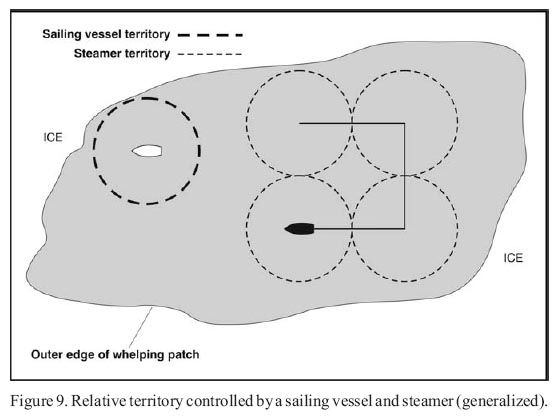
Display large image of Figure 9
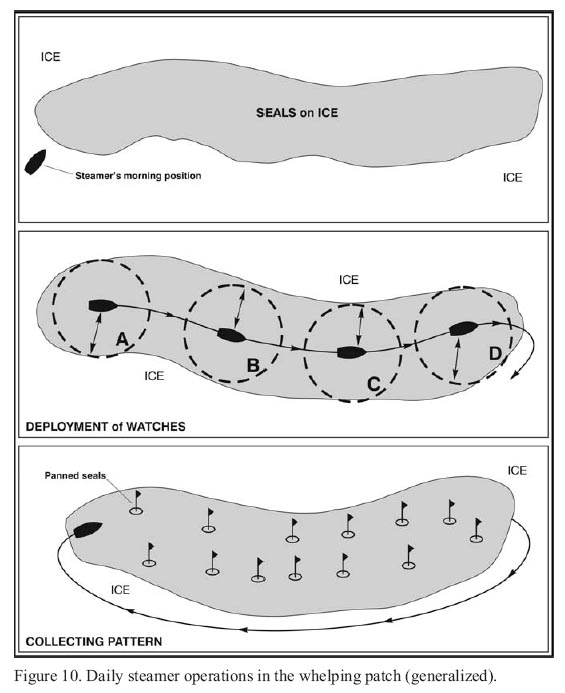
Display large image of Figure 10
35 With a watch normally able to kill all of the whitecoats in its immediate area before the steamer returned, the practice of "panning," or "bulking" — the gathering of pelts in central locations to facilitate collection (Report of the Commission of Enquiry into the Sealing Disasters of 1914, 1915) — became increasingly more important. Should time permit, master-watches were expected to set their men "doubling," an entirely new practice which required pans to be consolidated even further to facilitate collection (Figure 11). Steam-powered deck equipment such as winches and steel whip lines also offered advantages not previously available (Figure 12).
Figure 11. The Panning Process (generalized).

Display large image of Figure 11
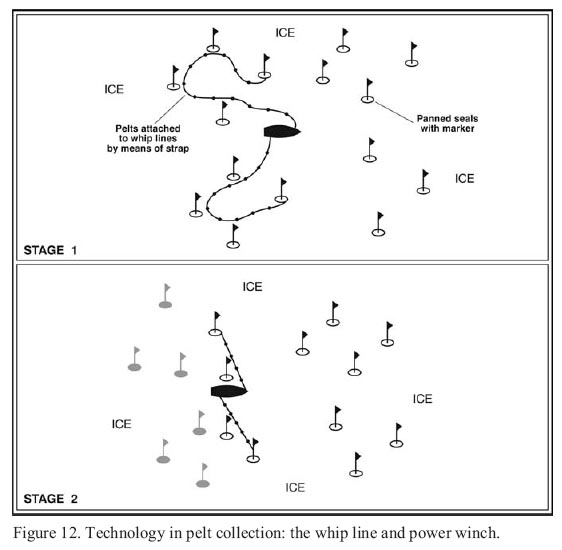
Display large image of Figure 12
36 Although sailing ship crews sometimes panned pelts, sealers more often had to drag their "tows" directly to the vessel (Jukes 1842, 275). It was not until steamers had been successfully introduced that bulking became common because they "could go around and chase after you when she put you off, but the sailing vessel couldn’t" (Vey 1971, personal communication).
37 The new techniques and strategies, while being more efficient, increased the possibility that larger numbers of men could be stranded. A master’s ability to interpret changing environmental conditions thus became more important for both success and crew safety. While steamers eased an individual sealer’s workload, men were now frequently required to be away from the relative security of their ship for longer periods. William Coaker, a member of the Newfoundland House of Assembly sailing on the Nascopie as an observer in 1914, for example, reported on 19 March that the last group of sealers had not been picked up until well after dark (The Daily Mail, 13 April 1914).
38 To better reduce risk, masters frequently left small, open boats with each watch. This practice not only made it easier and safer to work in loose ice, but they also provided protection against wind and cold when placed on their gunnels, and could be used "as a mark to find the spot if it was late before [the sealers] could be picked up" (The Daily Mail, 19 March 1914). Because it was not always possible to collect bulked seals before nightfall, men with lanterns were used to mark pans. An indication of just how dangerous this could be is provided by Captain George Barbour, who, testifying at the magisterial inquiry into the 1914 Newfoundland disaster, explained that "they don’t stay on the pans, they come aboard again, but sometimes they can’t get aboard because the ice gets loose and it is risky that way" (1915, 34).
39 Altogether, then, steamers could make on-ice harvesting more hazardous than during the sailing vessel era. In 1898, for example, 48 men perished when open water prevented them from returning to the Greenland which had become jammed, and in 1914 78 sealers from the Newfoundland froze to death when they were stranded on the ice for two full days and nights during a blizzard.13
40 Wastage also increased. As a knowledgeable St. John’s commentator complained in 1873: "At the lowest calculation I make bold to state that not less than from ten to twelve thousand pounds of currency worth of seals’ pelts is lost to the country each sealing voyage by the present system carried on by sealing masters and their crews!" (Carroll 1873, 34) Additionally, conflict between masters and crews increased as captains often took pelts panned by their competitors on the pretext that they had been "irretrievably lost." Captain L. Kean, a 30-year veteran, for example, noted that "sometimes you were blamed for taking other ship’s seals, but everyone did this, especially in the night" (Kean 1971, personal communication).
41 Increasingly forced to work in close quarters, masters developed the practice of having men "run-out" flags to "stake a claim" to as much of the whelping patch as possible. In 1972, for example, harvesting "corridors" were established by placing "marks" at regular intervals and by killing any whitecoats that lay directly in their path (Sanger 1972, personal observation; Figure 13; and Illustration 7). Captains, by mutual consent, were then expected to stand off a "fair distance." The interpretation of what constituted a fair distance, however, depended upon factors such as the size and shape of the whelping patch, the number of vessels working in the area, and the quality and quantity of pelts already safely stowed below deck.
Figure 13. Staking sealing territory (generalized).
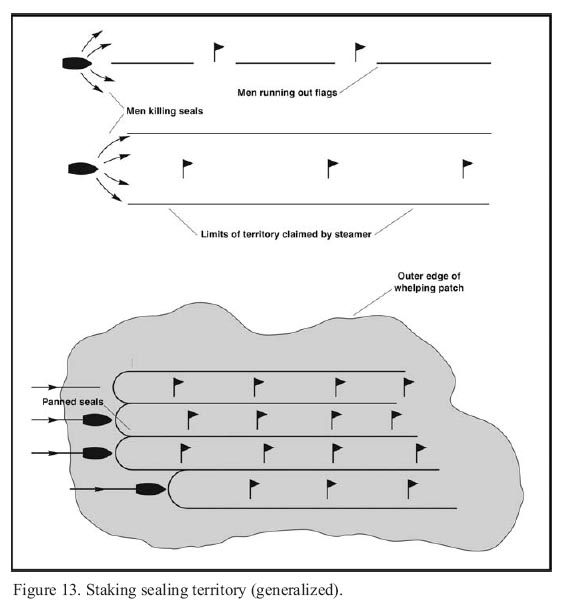
Display large image of Figure 13
42 Additionally, while each captain’s primary objective was to maximize profits, they were often conflicted between putting pelts safely stowed below at risk by taking additional chances should they be "poorly fished." On-ice clashes between competing watches thus became more frequent. As one seasoned sealer noted: "Yes, I see lots of fights. They’d run out with flags as fast as they could and try to stake out territory. Another fellow would come right alongside. As long as they got a seal was all that mattered" (Kean 1971, personal communication).
CONCLUSION
43 Sailing vessels represented a seasonally adjusted technology that changed sealing from a relatively passive and opportunistic economic activity into an important commercial venture, second only to the salt cod trade (for full details see Ryan 1994a). Whereas harp seals previously had been ensnared in nets while migrating south in late fall and early winter or when chance occurrence caused whelping and moulting herds to be carried onshore, settlers along the northeast coast of the island began actively to pursue whitecoat patches on the southward flowing pack ice in the early 1790s. By the middle of the nineteenth century, however, the unregulated sailing vessel hunt had become, in a sense, too successful and annual average and total catches began to decline.
Illustration 8. Canadian sealing fleet in whelping patch off northeastern Newfoundland: 1972.
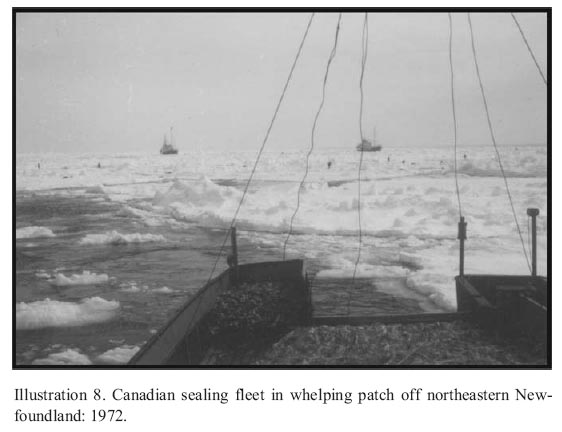
Display large image of Illustration 8
44 Before a more sustainable balance could be established between the scale of the effort and the pace of resource utilization, steam-powered vessels were introduced in 1863, significantly improving their ability to locate the severely depleted stock. Their greater maneuverability in pack ice also radically altered on-ice harvesting strategies and practices.
45 While the steamers’ ability to better cope with the difficulties and dangers posed by the natural environment initially increased average and total catches significantly (Figure1), in the long-term they proved to be too efficient. Within two decades, over-exploitation again caused the Newfoundland harp seal fishery to decline at an even faster pace than prior to 1863. This in turn profoundly changed the character, scale, and scope of the industry. Higher capital and fitting out costs, combined with escalating profit uncertainty, forced smaller outport merchants and entrepreneurs along the island’s northeast coast to withdraw, and St. John’s emerged as the dominant residential centre for vessel owners. Fewer ships, masters, and men participated, and the boundaries of regions representing owners, captains, and ordinary sealers also shifted dramatically (Figure 14).
Figure 14. Newfoundland sealing regions: 1863-1875 and 1876-1899.Acknowledgements
This paper is based upon "Technological and Spatial Adaptation in the Newfoundland Seal Fishery during the nineteenth Century," a historical geography MA thesis completed in 1973 at Memorial University of Newfoundland. I want to acknowledge the depth of gratitude I owe Alan G. Macpherson, professor emeritus, Department of Geography, MUN, who supervised the research, and the late Captain Morrisey Johnson, who made it possible for me to participate in the 1972 fishery. I am also grateful to Dr. Gordon Handcock for his insightful comments, to Charles Conway, who prepared the illustrations, and to Sharon Wall for assistance with the manuscript.References
An Act to Regulate the Prosecution of the Seal Fishery. 1873. Vic. Cap. 9, Sections 1 and 2.
Andrews, C. and Parker, R. 1971. Brief to the Special Advisory Committee to the Minister of Fisheries. St. John’s: Government of Newfoundland.
Anspach, L.A. 1819. A History of the Island of Newfoundland: Containing a Description of the Island, the Banks, the Fisheries, and Trade of Newfoundland and Labrador. London: T. and J. Allman.
Archibald, S.G. 1852. Some Account of the Seal Fishery of Newfoundland and the Mode of Preparing Seal Oil; with a Statement of the Advantages of Archibald’s Patent Steam Process for Rendering Seals and Other Animal Oils. Edinburgh: Murray and Gibb.
Barbour, Captain G. 1915. "In the Matter of the Inquiry into Disasters at the Seal Fishery of 1914." Proceedings: Special Reference to the Southern Cross. St. John’s: Provincial Archives of Newfoundland and Labrador.
Barry, D. 2005. Icy Battleground: Canada, the International Fund for Animal Welfare, and the Seal Hunt. St. John’s: Breakwater Books.
Black, W.A. 1960. "The Labrador Floater Fishery." Annals of the Association of American Geographers, 50: 267-95.
Bonnycastle, R.H. 1842. Newfoundland in 1842: A Sequel to "The Canadas in 1841." London: Henry Colburn.
Brown, C. 1972. Death on the Ice: The Great Newfoundland Sealing Disaster of 1914.Toronto: Doubleday.
Bursey, B.C. 1979. "A History of Economic Growth in Newfoundland." Preliminary draft report prepared for the Economic Council of Canada (reported in Hiller 1983-84).
Busch, B.C. 1985. The War Against the Seals: A History of the North American Seal Fishery. Montreal: McGill-Queens University Press.
Butt, J. 1998. "The Decline of the Migratory Fishery"; available from http://www.heritage.nf.ca/expoloration/decline.html; accessed 19 August 2008.
Candow, J.E. 1989. Of Men and Seals: A History of the Newfoundland Seal Hunt. Ottawa: Parks Canada.
Carroll, M. 1873. The Seal and Herring Fisheries of Newfoundland Together with a Condensed History of the Island. Montreal: John Lovell.
Chafe, L. 1924. Chafe’s Sealing Book: A History of the Newfoundland Sealfishery from the Earliest Available Records Down to and Including the Voyage of 1923. St. John’s: Trade Printers and Publishers.
Coaker, W. 1914. "Log of William Coaker of the Voyage of the Steamer Nascopi." The Daily Mail (St. John’s), 10, 23-17 April.
Cuff, R.H. 1991. "The Labrador Fishery." Encyclopedia of Newfoundland and Labrador, Vol. 3. St. John’s: Harry Cuff: 325-30.
Dundee Courier (Dundee, Scotland).
England, G.A. 1969. The Greatest Hunt in the World. Montreal: Tundra Books (originally published as Vikings of the North, 1924).
"Evidence taken by the Select Committee Appointed Upon the Present System of Carrying on the Seal Fishery." 1860-1861. Journal of the House of Assembly of Newfoundland .
Gosse, E. 1890. The Life of Philip Henry Gosse. London: Paul, Trench, Trubner.
Greene, Major W.H. 1933. The Wooden Walls among the Ice Floes, Telling the Romance of the Newfoundland Seal Fishery. London: Hutchinson.
Greenham, Captain A. 1971. Personal communication. Twillingate, NL.
Grenfell, W.T. 1897. "The Perils of the Frozen Sea: The Disaster of the Greenland." The Leisure Hour, New Series 23: 737-40.
Harrington, M.F. 1984. "Offbeat History." The Evening Telegram (St. John’s), 18 April.
——. 1986. Goin’ to the Ice: Offbeat History of the Newfoundland Seal Fishery. St. John’s: Harry Cuff Publications.
Harvey, M. 1873. "The Seal Hunters of Newfoundland." The Maritime Monthly,1.3.
Hatton, J. and Harvey, M. 1883. Newfoundland the Oldest British Colony, Its History, Its Present Condition, and Its Prospects in the Future. Boston: Doyle and Whittle.
Head, C.G. 1971. Eighteenth Century Newfoundland. Toronto: University of Toronto Press.
Hiller, J.K. 1983-4. "The Newfoundland Seal Fishery: An Historical Introduction." Bulletin of Canadian Studies, 7.2: 49-72.
Jackson, G. 1978. The British Whaling Trade. Hamden: Archon Books.
Jukes, J.B. 1842. Excursions In and About Newfoundland during the Years 1839 and 1840, Vol. 1. London: John Murray.
Kean, Captain A. 1935. Old and Young Ahead. London: Heath Cranton.
Kean, Captain L. 1971. Personal communication. Wesleyville, NL.
Keir, D.E. 1962. The Bowring Story. London: The Bodley Press.
LeMarchant, Governor G. 1848. Report from Governor LeMarchant to Earl Grey. C.O. 194: 129: 4 May.
Maxwell, Lt. W. 1874. "The Newfoundland Seal Fishery." Nature 10, 6 April.
Malouf, A.H. (Commission chair). 1986. Seals and Sealing in Canada, Vols. 1-3. Ottawa: Canadian Government Publishing Services.
McGrath, P.T. 1903. "Adventures on the Ice-Floes." The Cosmopolitan, 36. 1: 2-12.
Nansen, F. 1925. Hunting and Adventure in the Arctic. New York: Dunfield and Company.
Pearce, A. 1917. "Sealing Diary of Steamer Osprey." Colonial Commerce, 26. 5 and 7.
Peddel, N. 1908. Newfoundland Poems. Harbour Grace, NL: Standard Print.
Perry, Captain A. 1971. Personal communication. Newtown, NL.
Report of the Commission of Enquiry into the Sealing Disasters of 1914, 1915. Journal of the House of Assembly of Newfoundland (Third Session of the Twenty-Third General Assembly).
Ryan, S. 1971. "The Newfoundland Cod Fishery in the Nineteenth Century." MA thesis, Memorial University of Newfoundland.
——. 1986. Fish out of Water: The Newfoundland Salt Fish Trade, 1814-1914. St. John’s: Breakwater Books.
——. 1994a. The Ice Hunters: A History of Newfoundland Sealing to 1914. St. John’s: Breakwater Books.
——. 1994b. "Sealing." Encyclopedia of Newfoundland and Labrador, Vol. 5. St. John’s: Harry Cuff: 118-25.
——. 2007. "Changing Perspectives of Newfoundland Sealers and Sealing." Newfoundland Quarterly, 100. 2: 37-47.
Sanger, C.W. 1972. Personal participation and observation. Newfoundland Offshore Harp Seal Fishery on Board the Carino (Captain M. Johnson).
——. 1973. "Technological and Spatial Adaptation in the Newfoundland Seal Fishery during the 19th Century." MA thesis, Memorial University of Newfoundland.
——. 1977. "The Evolution of Sealing and the Spread of Permanent Settlement in Northeastern Newfoundland." In Mannion, J.J. (ed.). The Peopling of Newfoundland: Essays in Historical Geography. St. John’s: Institute of Social and Economic Research, 136-51.
——. 1980. "The 19th Century Newfoundland Seal Fishery and the Influence of Scottish Whalemen." Polar Record, 20. 126: 231-52.
——. 1985. "The Origins of the Scottish Northern Whale fishery. PhD thesis, University of Dundee.
——. 1988. "The Dundee — St. John’s Connection: Nineteenth Century Interlinkages between Scottish Arctic Whaling and the Newfoundland Seal Fishery." Newfoundland Studies, 4.1: 1-26.
——. 1998a. "Seal Fishery: Hunting Methods," on Newfoundland and Labrador Heritage Web Site; available from http://www.heritage.nf.ca/environment/sealing3_e.html; accessed 26 July 2008.
——. 1998b. "Seal Fishery Background: History, Resource and Natural Environment," on Newfoundland and Labrador heritage Web Site; available from http://www.heritage.nf.ca/environment/sealing1_e.html; accessed 26 June 2008.
Shortis, H.F. 1924. "The Sealing Fleet at its Zenith." The Evening Telegram (St. John’s): 1 March.
Sinclair, P.R., Hill, R.H., Lamson, C., and Williamson, H.A. 1987. Social and Cultural Aspects of Sealing in Atlantic Canada. St. John’s: Institue of Social and Economic Research, Report No. 5. Memorial University of Newfoundland.
Tait, R.H. 1939. Newfoundland: A Summary of the History and Development of Britain’s Oldest Colony From 1497 to 1939. New York: Harrington Press.
The Daily Mail (St. John’s).
The Newfoundland Express (St. John’s).
Tocque, P. 1895. Kaleidoscope Echoes, Being Historical, Philosophical, Scientific, and Theological Sketches from Miscellaneous Writings. Toronto: Hunter, Rice.
Vey, J. 1971. Personal communication. Grates Cove, NL.
Willey, A.D. 1907. "Seal Hunting on the Ice Floes of the North." Scientific American. 13 April.
Wilson, Rev. W. 1866. Newfoundland and its Missionaries. Halifax: Dakin and Metcalf.
Notes
